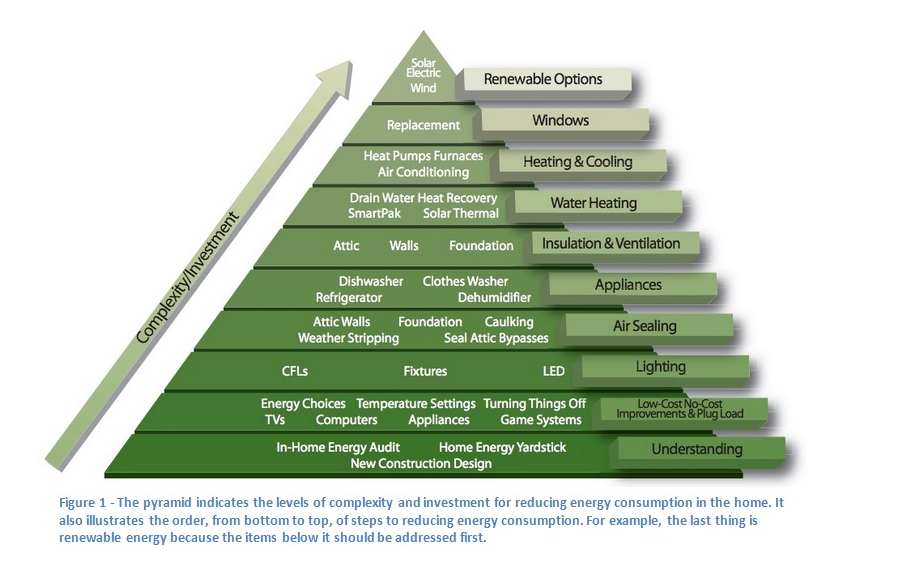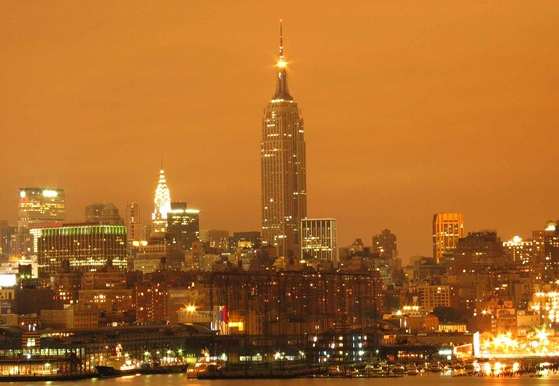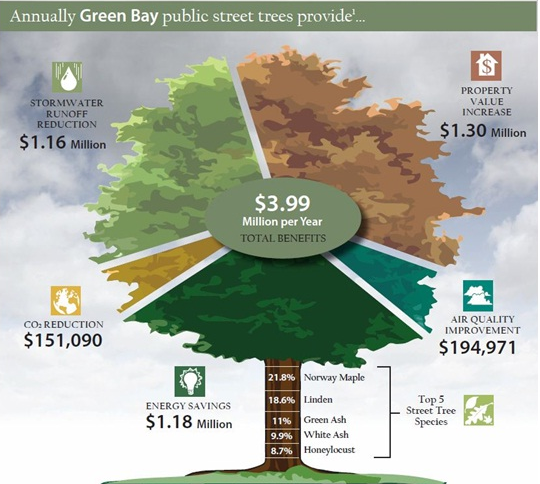Green and Sustainable Growth: Are We Finally Growing Up as a People?

Energy Conservation and Sustainability: Are We Growing Up as a World?
Look at this pyramid of energy efficiency for a typical house. Consider in the current world how many builders, architects and consumers are thinking about energy efficiency, in ways that we did not consider 30 years ago.
Some of the slowest to come around in development and support of new energy efficient concepts and in financing renewable energy concepts, have been bankers and lenders.
Yet there is considerable evidence that energy efficient buildings, are more profitable, more valuable and tend to attract longer-term tenants.
Yet we often wonder if people, consumers, home owners are the real problem. When we look at major Electric companies, we find that electricity generation from the giant “grid” plants, only delivers 35% of the energy that it consumes, to the grid. Coal plants are even less efficient that natural gas plants. What if that energy were created by individual owned wind turbines or solar panels, so that we would not have “line loss”? Or consider that coal creates a huge percentage of our nation’s air pollution. Dust from coal mines in Nevada and New Mexico, actually impacts forests In the northeast. Yet, as these old coal mines generate hundreds of millions of tons of pollution, the public rarely hears of this, rather, it seems that the public is advised to “stop polluting” as if we, the people were the problem. Once Tesla told J.P. Morgan (who had backed Thomas Edison and started General Electric), "We can create a system of energy that is renewable from natural sources. Humanity can have free energy, if you will back me financially." J.P. Morgan said: "If it is free where will we put the electric meters?" and from that day, he and Edison fought everything that Tesla did. Morgan and Edison's legacy is the huge power grid system that Americans and the world, are addicted to today. Tesla was right though, we can be free from it. If we will evolve in our thinking.
Another example are trucks and busses. The giant industries that manufacture them, don't like to admit that 100 old buses or trucks can create more air pollution than 3,000 cars. Yet, often public buses and old trucks are rarely regulated to the extent of private autos. The general public is told that he and his little car create the polluted air of our cities. But, in truth, the "big boys" are far more dirty to our air. Consider this, one coal fired electric plant in Nevada creates pollution that poisons the trees of New Hampshire. Hundreds of millions of tons of coal, burned to create electricity (at only 35% efficiency after line losses and other issues) which 300,000,oo0 Americans are addicted to daily.
And consider aviation. Airlines literally dump millions of tons of air pollution onto us from above. I was made aware of this when we had a home near the final runway of what was then called the Carswell Air Force Base. Our pool would cover up with tiny specks of black carbon, and we finally learned that this was coming from the B-52 bombers that constantly practiced their landings there. Medical studies show that people with homes next to airports have a 60% higher incidence of lung disease, and if they have small children, those infants are at risk of long-term lung disease.
Another issue we face in the modern world is the environmental impact of cities simply existing. Cities become islands of heat and the annual mean air temperature at a city, just after sunset can be as much as 22 degrees F warmer. This creates new issues, as additional greenhouse gases are created to air condition the otter city areas. The “heat island” effect is something that seems to come out of a science fiction novel, but it is real.
SKYGLOW:
It is that yellowish glow above cities at night, obscuring the stars. It is city light reflecting off of pollution particles. It is like a symbol of how we live and a “night sign” of our lifestyle.
A few solutions: More and more buildings are planting “greenhouse rooftop gardens”, to cool the roofs, cool the buildings as they let plants do “their thing”. Some builders are putting solar panels on roofs, and this not only absorbs the heat, shades the roof but creates electricity. Some roofs are coated with white or reflective materials. A typical residential building with a metal silver reflective roof will generate 30% less attic heat.
Cool paving. A standard asphalt highway can generate temperatures in excess of 150 degrees F. But a lighter color, or concrete road will be closer to 100 degrees F.
But in spite of the polluters we still have thinkers. In Vancouver, and in Chicago, city leadership has emphasized the value of trees to the community. Vancouver has estimated that public trees contribute or save the city $3.9 million per year by stormwater runoff reduction, CO2 reduction, property value increases, air quality improvement and energy savings due to shading.
OTHER BENEFITS OF GOING ‘GREEN’:

The U.S. Green Building Council reports that:
- Building sale prices for green buildings are 10% higher per square foot.
- Green office buildings with skylights and improved low intensity lighting have a 27% lower incidence of headaches
- Stores with skylights indicate much lower electric bills
- Green buildings consume 26% less electricity
- Green buildings have a 13.6% lower operating cost
- Green buildings have lower occupant tenant “turnover”
- Green buildings show a longer average lease term and 7% higher lease rates
- For every $1 in energy savings for a green building, the value of that building increases $20.
The initial question was, are we as a people “growing up”. After educating, writing, speaking, and promoting sustainability and green concepts, we are slowly, through the leadership of government, universities, cities and trade organizations, seeing tangible and broad movement to more environmentally sensitive development and living.
20 years from now, the idea of “net zero” buildings will be a practical reality. Keep it up! Ben Boothe, Publisher BootheGlobalPerspectives.com